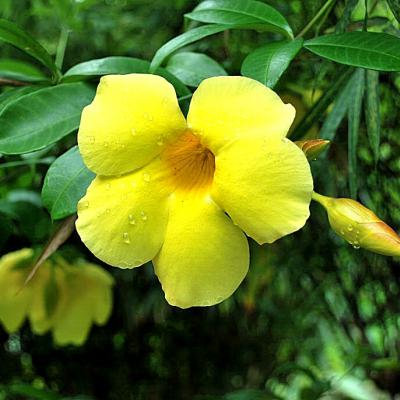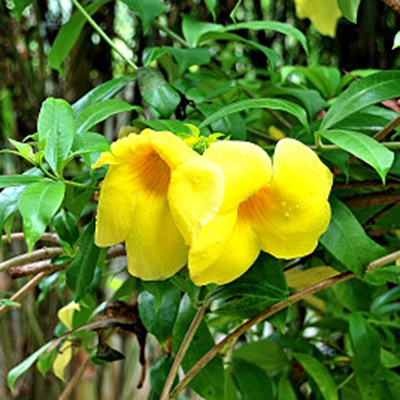Apocynaceae-Allamanda-cathartica L. var. hendersonii
Classification
- Botanical Family : Apocynaceae
- Genus : Allamanda
- Epithet : cathartica L. var. hendersonii
- German Family Name: Hundsgiftgewächse
- English Name: Golden Trumpet, Yellow Bell
- Thai Name: บานบุรีสีเลือง
- Thai Phonetic: baan buri si lüang
- Author: L.H.Bailey & Raffill
Water Requirements
Plant Type
Light Requirements
Cultivation
Allamanda cathartica L. var hendersonii a climbing shrub that is evergreen. He has large, very showy bright yellow blooms that are trumpet-shaped. It blooms almost all year round. The scent is delicate and fruity and just to smell at night. The flower has five overlapping petals. The still closed buds are light brown at the beginning.
The individual branches can grow up to 3 m. But then the branches are bare from below. A regular pruning is recommended. The shrub will grow more bushy and at the new tips growing the flowers.
The plant has no thorns or tendrils, it therefore require support in the form of trellises, to keep its upright shape. The shrub is turning into a certain direction. The attempt to change the direction, can damage the plant!
Allamanda cathartica L. var. hendersonii grows well in most soils, but becomes chlorotic in very alkaline conditions. Feels well in moist substrates. The soil should not dry out.
Prefers for full flowering a sunny place or a place in light shade.
All parts of plant are poisonous. The white milky sap can cause skin irritations.
Propagation: By cuttings of older shoots which have still leaves, by sowing or root division.
Allamanda cathartica L. var. hendersonii ist ein kletternder Strauch, der immergrün ist. Er hat große, sehr auffällige leuchtend gelbe Blühten, die trompetenförmig sind. Er blüht fast das ganze Jahr hindurch. Der Duft ist zart und fruchtig und nur nachts zu riechen. Die Blüte hat 5 sich überlappende Blütenblätter. Die noch geschlossenen Knospen sind zu Beginn hellbraun.
Die einzelnen Zweige können bis 3 m lang werden. Dann allerdings werden die Äste von unten her kahl. Ein regelmäßiger Schnitt wird daher empfohlen. Der Strauch ist dann buschiger und an den neuen Triebenden bilden sich die Blüten.
Die Pflanze hat weder Dornen noch Ranken, sie verlangt deshalb Unterstützung in Form von Rankhilfen, um seine aufrechte Form zu halten. Der Strauch dreht sich in eine bestimmten Richtung. Der Versuch, die Richtung zu ändern, kann zu Schäden an der Pflanze führen!
Allamanda cathartica L. var. hendersonii wächst auf den meisten Böden gut, außer auf sehr alkalischen. Fühlt sich in feuchten Substraten wohl. Der Boden sollte nicht austrocknen.
Bevorzugt zur Blütenbildung einen sonnigen bis leicht schattigen Platz.
Alle Teile der Pflanzen sind giftig. Der weiße Milchsaft kann Hautirritationen hervorrufen.
Vermehrung: durch Stecklinge von älteren Trieben, die aber noch Blätter haben, durch Aussaat oder Wurzelteilung.
Origin
Miscelaneous
Ethnomedical uses
The ethnomedical information is provided for general information only, it is not intended as guidance for medicinal use.
Leafes, flowers and roots are used.
Trinidad - Allamanda cathartica used in traditional medicine for treating malaria and jaundice.
A positive antibacterial wound healing could be demonstrated in a study in rats. (1)
Extracts of leaves, roots and flowers have been shown to have in vivo anti-tumour activity against leukaemia in mice, and against human carcinoma of the nasopharynx (nasal cavity and upper part of the throat) in culture. Leaf and root decoctions are used as a laxative and emetic in traditional medicine in a number of tropical countries, but large doses are toxic. (2)
(1) Evaluation of wound healing activity of Allamanda cathartica. L. and Laurus nobilis. L. extracts on rats Shivananda Nayak,1 Poorna Nalabothu,1 Steve Sandiford,1 Vidyasagar Bhogadi,1 and Andrew Adogwa2
Volksmedizinische Verwendung
Die Berichte über volksmedizinische Verwendung ist nur zur allgemeinen Information und nicht als medizinischer Ratgeber zu betrachten.
Verwendet werden Blätter, Blüten und Wurzel.
Trinidad - Allamanda cathartica wird als Mittel gegen Malaria und Gelbsucht eingesetzt.
Eine positive antibakterielle Wundheilung konnte in einer Studie an Ratten bewiesen werden. (1)
Extrakte von Blättern, Wurzeln und Blüten haben eine in vivo Anti-Tumor-Aktivität gegen Leukämie bei Mäusen und gegen die Karzinome des Nasopharynx (Nasenhöhle und oberen Teil des Halses) beim Menschen in angesetzter Kultur. Blätter- und Wurzelabkochungen werden als Abführmittel und Brechmittel in der traditionellen Medizin in einer Reihe von tropischen Ländern verwendet, aber große Dosen sind giftig. (2)
(1) Evaluation of wound healing activity of Allamanda cathartica. L. and Laurus nobilis. L. extracts on rats Shivananda Nayak,1 Poorna Nalabothu,1 Steve Sandiford,1 Vidyasagar Bhogadi,1 and Andrew Adogwa2


